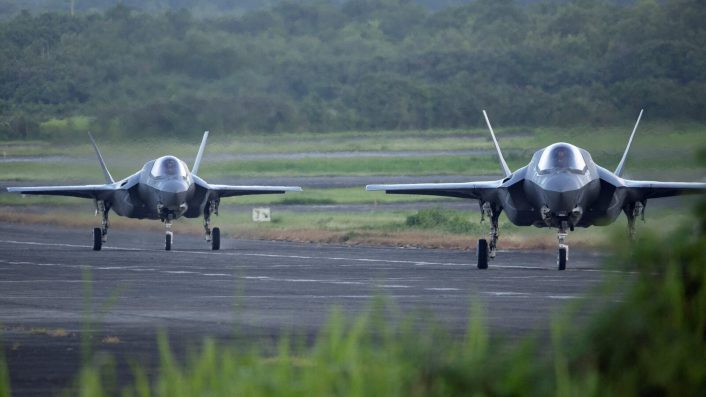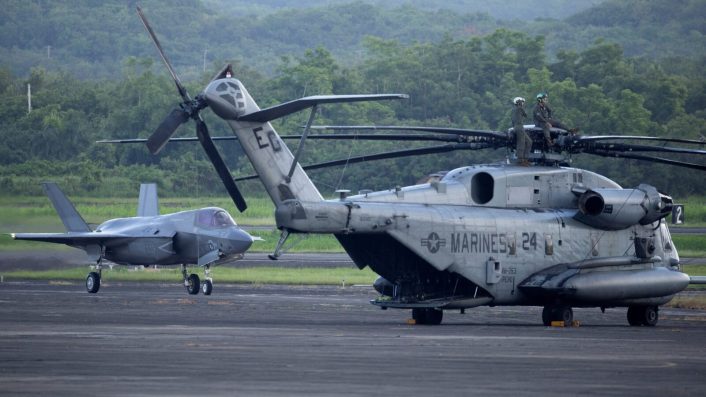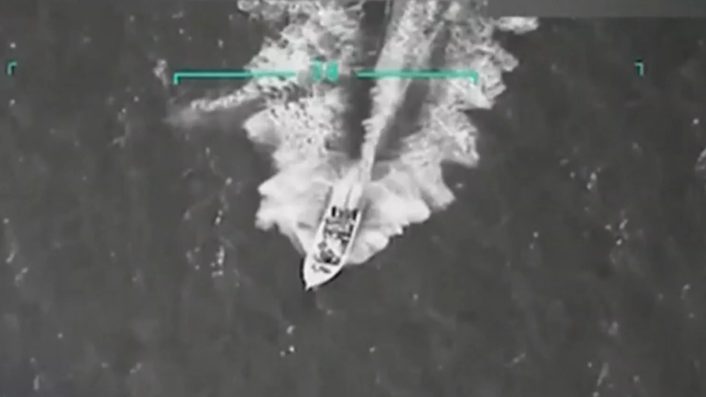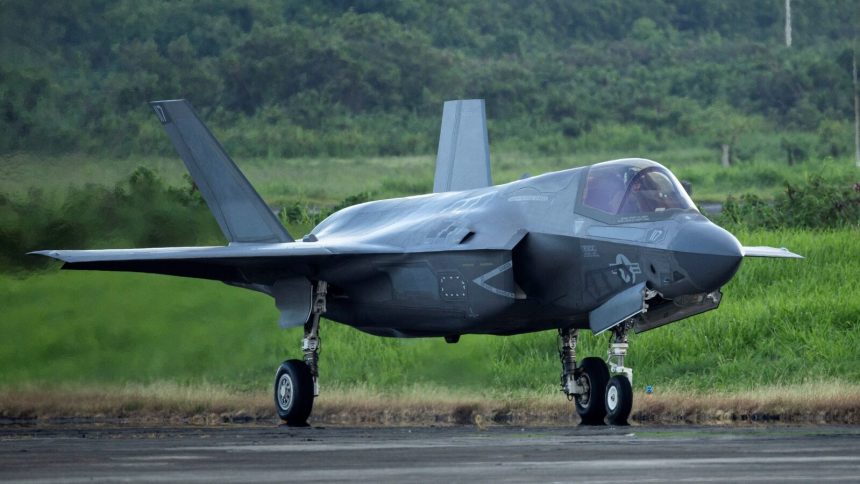The first of ten F-35s arrived in Puerto Rico, notably showing their unit insignias removed.
A flight of F-35B Lightning II stealth fighters has arrived in Puerto Rico, joining a broader and visibly expanded U.S. military posture in the Caribbean that U.S. officials tie to counter-drug operations. The news about the imminent deployment was first disclosed on Sept. 5, 2025, as a consequence of the flight of two Venezuelan F-16s near a U.S. vessel.
F-35s Touch Down in Puerto Rico
Photos and open-source tracking first showed F-35s landing at the former Roosevelt Roads naval complex in Ceiba, Puerto Rico. A Reuters photographer captured images of five F-35s touching down there on Sept. 13, while open-source tracking shows additional jets arriving from Marine Corps Air Station Yuma via MacDill Air Force Base.
F-35 fighters have arrived at the former Roosevelt Roads Naval Station in Ceiba, Puerto Rico, now operating as the primary staging base for the aircraft and their support teams.
Thanks to @HRPlanespotter for capturing the landings! pic.twitter.com/LMC8Lm6XFb
— GMI (@Global_Mil_Info) September 13, 2025
Photo evidence suggests at least some of the fighters were refueled en route by a KC-135 Stratotanker near Miami, Florida. Multiple tankers were tracked while in flight with the “GOLD” callsign, usually associated with ferry flights in support of fighters.
📍Miami, #UnitedStates (🇺🇸)
Miami-based plane spotter @/Soflonikonuser was able to capture 5x F-35Bs undergoing aerial refueling from a @usairforce KC-135R Stratotanker above Miami en route towards Puerto Rico.
The US is to deploy a total of 10x from PR to reinforce assets. https://t.co/mtoxcyqXm4 pic.twitter.com/Rzy55xuIel
— SA Defensa (@SA_Defensa) September 13, 2025
In total, two flights of F-35s were reported leaving MCAS Yuma. The first flight, callsign “MAZDA11” included six F-35Bs and departed on Sep. 12, while the second flight, callsign “MAZDA21” included five F-35Bs and departed on Sep. 13.
Six F-35s departed from MCAS Yuma #KNYL to José Aponte de la Torre Airport #TJRV as MAZDA 11 flight, today September 12th 2025. This is the former Roosevelt Roads Naval Station, Puerto Rico #TJNR. Supporting #ALTRV Coronet South 814 was GOLD 61 (59-1460) #CS814 #CoronetSouth pic.twitter.com/yVC74SeEYp
— Coronet_deployments 🇳🇱 🇺🇸 (@CoronetEast) September 12, 2025
Five more F-35s departed from MCAS Yuma #KNYL to José Aponte de la Torre Airport #TJRV as MAZDA 21 flight, today September 13th 2025. Supporting #ALTRV Coronet South 814 were #GOLD61 (59-1460), #GOLD62 (59-1453) and #GOLD63 (58-0094) #CoronetSouth #CS814 #MAZDA21 pic.twitter.com/HULrPdVzxS
— Coronet_deployments 🇳🇱 🇺🇸 (@CoronetEast) September 13, 2025
Notably, the photographs of the F-35s landing at Ceiba showed the jets without visible unit tail and fuselage markings. The absence of clear identifiers has raised questions among observers, although it is being considered as a deliberate measure to enhance operational security and reduce attribution of the deployed jets to the units involved.
F-35B Lightning lls with the U.S. Marine Corps’ 3rd Marine Aircraft Wing (3rd MAW) arriving earlier today at Roosevelt Roads Naval Station in Eastern Puerto Rico. pic.twitter.com/vEmqZKur0W
— OSINTdefender (@sentdefender) September 14, 2025
However, photos captured at the airfield show personnel with unit patches clearly visible. This detail, together with the Bureau Numbers and Modex, allowed observers to deduce that the F-35s and personnel might have been chosen from multiple units.
Definitely 🇺🇸 USMC F-35Bs in 🇵🇷 Puerto Rico now.
Pic by Marlyn Garcia via FB https://t.co/SGChhcOKAD pic.twitter.com/Ls8rw3TBrZ
— Evergreen Intel (@vcdgf555) September 13, 2025
Operational Details Remain Unclear
The Pentagon has been cautious in public statements. A Pentagon duty press officer told Reuters the department had “no force posture changes to announce currently.” Notably, senior officials – including Secretary of War Pete Hegseth and the Chairman of the Joint Chiefs of Staff General Dan Caine – made unannounced visits to forces in Puerto Rico.

Neither the exact number of aircraft that will remain in Puerto Rico nor their service branch or variant has been confirmed publicly, although we now know from public reporting that the jets involved are U.S. Marine Corps’ F-35Bs. However, while the arrival of F-35s in Puerto Rico is the most visible element yet of a widened U.S. military footprint in the Caribbean, it is not the only arrival.
🇵🇷🇺🇸 Ceiba/Roosevelt Roads looks back in business.
Pics by Ricardo Arduengo w/ Reuters pic.twitter.com/aZcuNREcgo
— Evergreen Intel (@vcdgf555) September 14, 2025
Air & Space Forces Magazine and other outlets have reported sightings of additional air assets in the territory, including MQ-9 Reaper drones, KC-135 and KC-46 tankers, and frequent C-17 cargo flights that appear to be supporting an expanded logistics footprint. Some of these movements were also photographed by Reuters.
What the F-35s Bring
Observers and analysts emphasize that the F-35’s value in the region extends beyond air-to-air combat. As we previously noted here at The Aviationist, the fifth-generation platform combines advanced strike capability with extremely capable sensors and data-fusion systems that make it a powerful nontraditional Intelligence, Surveillance and Reconnaissance (ISR) asset.
F-35 fighter jets taxi on the runway at the former Roosevelt Roads military base in Ceiba, Puerto Rico, September 13, 2025. REUTERS/Ricardo Arduengo pic.twitter.com/9mlcnNOJbY
— Idrees Ali (@idreesali114) September 13, 2025
The aircraft’s AESA radar and electro-optical suites can collect and fuse information that is distributed across command networks, enhancing maritime and overland situational awareness in complex environments. This multiplies the effectiveness of any force package it supports, making the aircraft not only a deterrent through presence but also a force enabler that enhances situational awareness and operational decision-making in contested environments.

Context: the Strike that Changed Posture
As mentioned in the opening, the news about the F-35’s deployment was first publicized on Sept. 5, 2025, as a consequence of the flight of two Venezuelan F-16s near a U.S. vessel. Hours after the announcement, Venezuelan jets flew a second time over a U.S. warship, identified as the USS Jason Dunham, which was reportedly the same which experienced the interaction with Venezuelan F-16s the day earlier.
The overflights themselves were a consequence of the lethal strike against a suspected Venezuelan drug vessel in the southern Caribbean, carried out by the U.S. military on Sep. 2, 2025. This was the first known use of direct military force against a drug cartel’s maritime operations since the deployment of additional U.S. warships to the region.

As we reported, the strike provoked questions about legality and proportionality, withs legal and human-rights concerns raised by scholars and some members of Congress, who questioned whether lethal force in international waters was consistent with international law and traditional interdiction practice. Critics also point out the unusual nature of using high-end airpower for maritime drug interdiction when law enforcement boarding and seizure have historically been the norm.
Regional signal and escalation risk
U.S. officials frame the deployments primarily as counter-narcotics operations designed to disrupt maritime trafficking and protect U.S. forces and vessels operating in international waters. Nevertheless, the scale and visibility of the buildup—a mix of surface combatants, submarine assets, thousands of Marines and new airpower—have been interpreted by some observers as a broader signal to Caracas.
Caracas has accused Washington of using counter-narcotics as a pretext for pressure or regime change. The latter maintains that the goal of the operation is to stop the downpour of drugs in the U.S. cities, although the Trump administration has also doubled its bounty on Venezuelan President Nicolás Maduro to $50 million, accusing him of supporting drug trafficking and criminal networks, according to Reuters and CNN.
That environment, however, elevates the risk calculus, as there is the potential for miscalculation during close maneuvers at sea and the political sensitivity of strikes or shoot-downs. President Trump’s public comments warning that Venezuelan aircraft could be shot down if they placed U.S. ships “in a dangerous position” signal that the situation might become tense at any point in future if events are misjudged.









